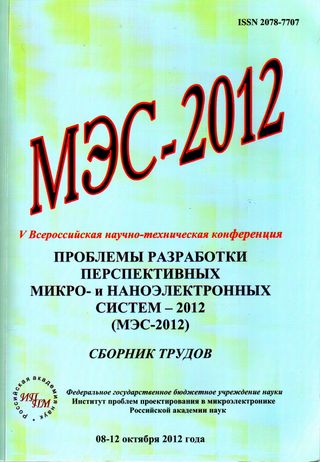?
Создание IBIS моделей цифровых микросхем с учетом воздействия внешних факторов
С. 187–192.
In book

М.: ИППМ РАН, 2012.
Иванов Р. В., Михальский А.И., Иванов В. К. et al., В кн.: XII Всероссийское совещание по проблемам управления. ВСПУ-2014. Москва, 16-19 июня 2014 г.: Труды [Электронный ресурс]. М.: Институт проблем управления им. В.А. Трапезникова РАН, 2014. С. 6463–6471.
В работе предложена методология идентификации моделей радиационных рисков заболеваемости человека и оценки их параметров гетерогенности по данным ко-гортного исследования. Гетерогенный фактор моделируется с помощью гамма распре-деления. Рассмотрены модели с пропорциональным риском и избыточным относитель-ным риском. Оценивание параметров осуществлено с помощью метода наибольшего правдоподобия. Получены точные аналитические формулы для функций правдоподобия в случаях полной и неполной ...
Added: December 19, 2014
Petrosyants K. O., Kharitonov I. A., Sambursky L. M. et al., , in: Proceedings of IEEE East-West Design & Test Symposium (EWDTS’12). Kharkov: Kharkov national university of radioelectronics, 2012. P. 60–65.
An EKV-RAD macromodel for SOI/SOS MOSFET with account for radiation effects is developed using a subcircuit approach. As an addition to the standard version of the EKV model 1) radiation dependencies of parameters VTO, GAMMA, KP, E0 are introduced and 2) additional circuit elements to account for floating-body effects and radiation-induced leakage currents under static ...
Added: January 22, 2013
Влияние различных видов радиации на характеристики кремний-германиевых гетеропереходных транзисторов
Петросянц К. О., Самбурский Л. М., Харитонов И. А., Электронная техника. Серия 2: Полупроводниковые приборы 2014 № 1 (232) С. 3–18
An overview is given of published papers on investigations of ionizing radiation influence (gamma, neutron, and proton) on characteristics of silicon-germanium heterojunction transistors -- elements of SiGe BiCMOS integrated circuits of 4 generations with design rules 0.25, 0.18, 0.13, and 0.09 um. Experimental data are explained on the basis of modern understanding of radiation effects in ...
Added: September 18, 2014
М.: ФГБНУ "НИИ ПМТ", 2013.
Труды содержат доклады, представленные учеными из России, Украины, Белоруссии, Казахстана,Эстонии, Узбекистана, Германии, Польши, посвященные актуальным проблемам радиационной физики твердого тела (влияние радиации на физико-химические свойства и структуру металлических, полупроводниковых и диэлектрических материалов, влияние факторов космического пространства на свойства конструкционных и функциональных материалов и покрытий космических аппаратов, радиационно-технологические методы получения материалов, в частности наноматериалов, модифицирования и ...
Added: September 27, 2013
М.: ФГБНУ "НИИ ПМТ", 2014.
Труды содержат доклады, представленные учеными из России, Белоруссии, Казахстана,Узбекистана, Украины, Киргизии, Германии, США, Польши, ЮАР, посвященные актуальным проблемам радиационной физики твердого тела (влияние радиации на физико-химические свойства и структуру металлических, полупроводниковых и диэлектрических материалов, влияние факторов космического пространства на свойства конструкционных и функциональных материалов и покрытий космических аппаратов, радиационно-технологические методы получения материалов, в частности наноматериалов, ...
Added: July 15, 2014
Petrosyants K. O., Sambursky L. M., Kharitonov I. A. et al., Russian Microelectronics 2011 Vol. 40 No. 7 P. 457–462
A compact BSIMSOI-RAD macromodel for SOI/SOS CMOS transistors is developed that takes into account the radiation effects. An automated procedure for determination of macromodel parameters is described and shown to be useful for analyzing radiation hardness of CMOS IC fragments depending on the total absorbed dose. The simulation time is estimated. ...
Added: April 12, 2012
Petrosyants K. O., Kharitonov I. A., Sambursky L. M. et al., В кн.: Тезисы докладов 18 Всероссийской научно-технической конференции по радиационной стойкости электронных систем "Стойкость 2015". Научно-технический сборник. Лыткарино МО: [б.и.], 2015. С. 109–110.
Для модифицированных схемотехнических моделей электронных компонентов как в дискретном, так и в интегральном исполнении, учитывающих эффекты основных видов радиационного воздействия, отработаны методики измерений их характеристик в процессе и после радиационного воздействия и определения параметров их моделей из результатов измерений. ...
Added: September 18, 2015
Petrosyants K., Kozynko P., Kharitonov I. A. et al., , in: Proceedings of IEEE East-West Design & Test Symposium (EWDTS’12). Kharkov: Kharkov national university of radioelectronics, 2012. P. 289–292.
Automated electro-thermal analysis is realized in the last version of Mentor Graphics PCB Design System. The special software tool AETA is developed and integrated into the Expedition Enterprise PCB Design System to automate the process of power-temperature traffic between electrical and thermal simulators. Furthermore AETA provides the graphical user interface and the possibility to use ...
Added: December 23, 2012
К. О. Петросянц, М. В. Кожухов, Смирнов Д. С., Известия высших учебных заведений. Электроника 2013 № 6 С. 85–87
В настоящей работе приводятся экспериментальные результаты влияния изохронного и изотермического отжига на процесс восстановления статического коэффициента усиления h21E биполярного транзистора гигагерцового диапазона, подвергнутого облучению гамма-квантами. Определяются оптимальные значения температуры и времени отжига, обеспечивающие восстановление коэффициента усиления до значений, наблюдаемых у необлученных транзисторов. ...
Added: January 29, 2014
Petrosyants K. O., Sambursky L. M., Kharitonov I. A. et al., Известия высших учебных заведений. Электроника 2011 № 1 (87) С. 20–28
Разработана компактная макромодель BSIMSOI-RAD для КНИ/КНС КМОП-транзисторов, учитывающая факторы радиационного воздействия. Описана автоматизированная процедура определения параметров макромодели, показаны возможности ее использования для анализа радиационной стойкости схемных фрагментов КМОП БИС в зависимости от суммарной поглощенной дозы. Приведены оценки затрат времени на моделирование. ...
Added: April 19, 2012
Изменения в поверхностных слоях медных сплавов под действием импульсной пучково-плазменной обработки
Епифанов Н. А., Пименов В. Н., Боровицкая И. В. et al., В кн.: Труды ХХХ Международной конференции «Радиационная физика твердого тела» (Севастополь, 22 августа – 29 августа 2020г.). М.: ФГБНУ "НИИ ПМТ", 2020. С. 83–95.
Added: September 10, 2020
Andreev V. V., Bondarenko G., Maslovsky V. M. et al., IOP Conference Series: Materials Science and Engineering (MSE) 2012 Vol. 41 No. 012017 P. 1–9
In this study, a new technique of multilevel current stress for investigation thin oxide layers of MOS structures is proposed. This technique allows to investigate the generation and relaxation of positive and negative charges, accumulating in, nano-thickness gate dielectric of MOS structures under many stressing situations. The parameters characterizing the change of charge state in ...
Added: January 17, 2013